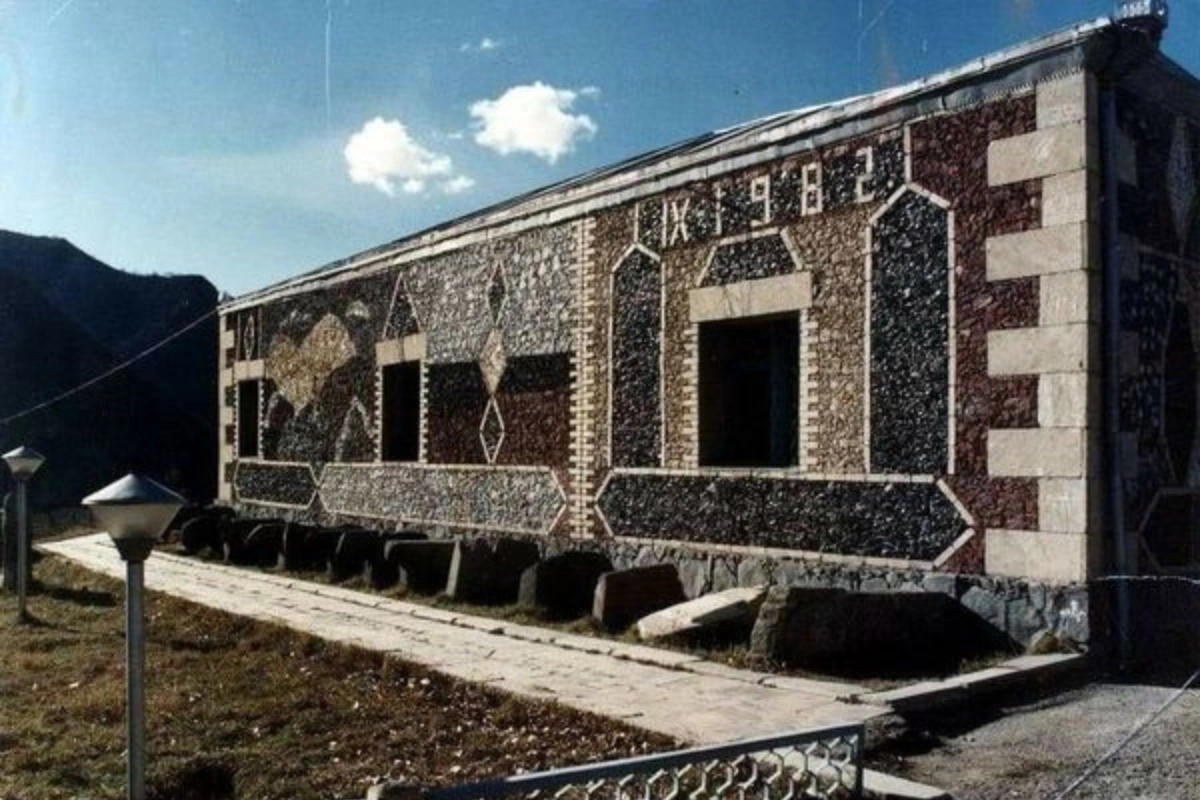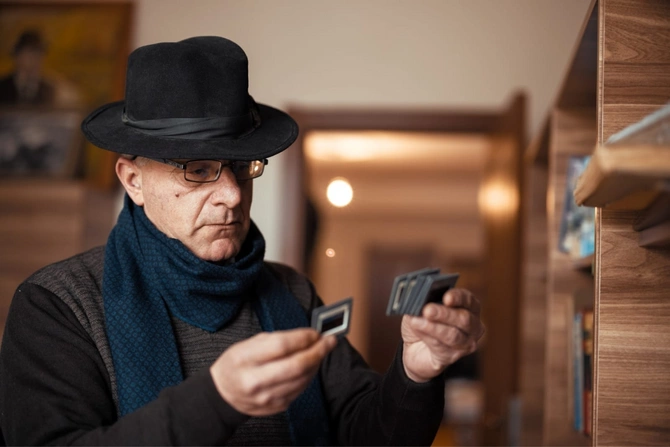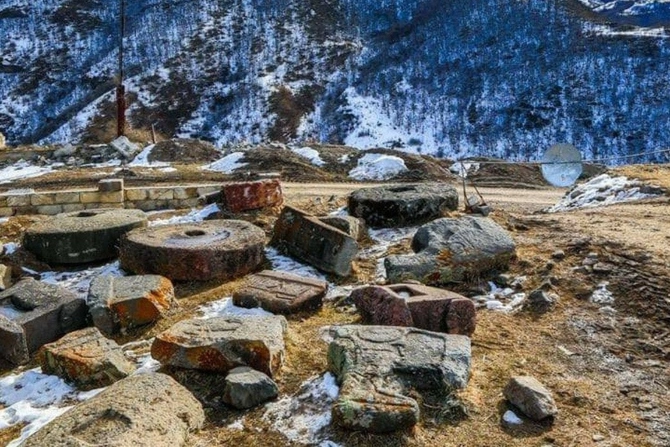
Kalbajar's History and Ethnography Museum was once one of the most visited museums in Azerbaijan. However, after the Armenian armed forces occupied Kalbajar in 1993, the museum was destroyed and looted.
Kalbajar Museum of History and Ethnography in 1991, prior to occupation. Image: Khalid Asgarov
On a cold March day in 1993, 64-year-old Shamil Asgarov, a resident of Kalbajar, looked at his books, which he has collected and carefully preserved over the years, for the last time:
“My only wealth is these books,” he says emotionally, while his son, Reuter’s reporter Khalid Asgarov, captured the moment.
Shamil Asgarov left behind not merely the 30,000 books he had amassed over the years but also the Kalbajar History and Ethnography Museum, which he referred to as his child and devoted 14 years of his life to its development.
“It's okay if my house remains abandoned; it's okay if it falls apart. The museum is like my other child. There are such relics that could adorn the museums of the world,” said Asgarov with pain in his voice. Asgarov knew that their time was limited as Armenian armed forces could enter the city at any time.
“Hurry up, we have to go,” urged his son Khalid. At that moment, he hurriedly took three to four books from the floor and bid farewell to his home, his books, his museum, and his beloved Kalbajar. These were the final moments he spent in the city, moments he would never witness again.
The concept of establishing the Kalbajar History and Ethnography Museum, which Shamil Asgarov subsequently called the ‘Martyr Museum’ after the occupation of Kalbajar, first arose in 1975 during the Azerbaijani Geologists' Congress at the Azerbaijan National Academy. An exhibition showcasing local historical materials prepared by teachers and students from schools attending the congress garnered significant acclaim. This led to the recognition of the necessity for a history and geography museum in Kalbajar. This thrilled both the residents of Kalbajar and Shamil Asgarov, a mathematician, poet, linguist, translator, and candidate of philological sciences—who was also one of the respected names of Kalbajar. The museum’s construction started in 1980 and the museum was opened in 1982.
The museum’s extraordinary exterior walls were adorned with mosaic patterns crafted from Kalbajar’s mountain rocks. Shamil Asgarov took an active role in the construction, personally gathering over 2500 stones of different colours from the Kalbajar mountains and the Terter river to embellish the museum's façade.
The museum had 30,000 unique antiquities—stone bowls, mauls, knives, nephrite adze blades, ancient pottery, copper tableware, ancient household items, and hundreds of hand-woven carpets. Additionally, it contained 25,000 rare or one-of-a-kind books, poetry collections, and manuscripts.
Interestingly, 150 million-year-old petrified snail samples found by Shamil Asgarov in the Terter river were also exhibited in the museum.

Barzani Asgarov. Image: courtesy
Shamil Asgarov’s son Barzani Asgarov mentions that the museum also served as a sound museum, showcasing recordings of over 300 renowned Azerbaijani poets, writers, and ashiqs.
Kalbajar’s residents played a significant role in the museum's growth by donating ancestral souvenirs, ensuring their preservation at the museum.
“Entering that museum was like traveling to historical times. I was a kid then, and when I found something in the mountains, I would bring it to the museum, thinking it might be useful,” remembers Hikmet Asgarov, Shamil Asgarov's nephew.
Now, there are only ruins where the museum once stood.
Following the massacre of Agdaban village’s residents by Armenian Armed Forces in 1992, Shamil Asgarov realized that the occupation of Kalbajar was imminent.
His son Barzani Asgarov says that despite his father’s appeals to various authorities, including then-President Abulfaz Elchibey, to transport the relics to Baku by car, his efforts went unanswered.

Ruins of Kalbajar muesum. Image: Reza Deghati
After Kalbajar’s occupation on 3 April 1993, the museum was looted—most of the museum’s relics were moved to Armenia, while others were moved to Khankendi and Hadrut and exhibited as “Artsakh history” items.
“We couldn't bring anything from the museum, so we closed the doors of the museum and took nine keys with us,” says Barzani Asgarov.
These nine keys are now exhibited in the Kalbajar History and Ethnography Museum in Baku. In 1993, Shamil Asgarov turned a school classroom into a museum in Baku, which he called the Witness Museum. He served as the its director until his death in 2005.
In 2017, the museum’s current director, Barzani Asgarov, bought a house and donated it to the museum. Now more than 300 items are exhibited in the museum. Barzani says that he founded this museum with his own efforts and received no support from the Ministry of Culture, with some artifacts showcased in the museum being donated by individuals from various regions of Azerbaijan.
Despite numerous challenges, Barzani Asgarov managed to reclaim nearly 150 items that his father originally sent to various museums in Baku for temporary exhibition before the occupation of Kalbajar.
Shamil Asgarov’s nephew, Hikmet Asgarov, a photographer and journalist, was among the first to enter Kalbajar when it was liberated on 26 November 2020. After returning for the first time since he was 13, Hikmet's first stop was his uncle's museum and house. He says only one wall of the museum was standing during the occupation years. However, after the ceasefire agreement ending the Second Karabakh War, the Armenians requested 15 days to evacuate and demolished the last remaining wall before departing.
Trees now grow on the site of Shamil Asgarov's house and his beloved library, which was looted and burned.
“There is only one iron table left in our house. Our house was one of the most beautiful houses in the village. The interesting thing is that they demolished that beautiful house instead of living there. The Armenians who settled there lived in the chicken coop next to our house. I don't understand why they did this,” says Barzani.
Now whenever Hikmet and Barzani Asgarov journey to Kalbajar, they scour the region to find anything in Kalbajar’s mountains and under the museum’s ruins. Their sole desire is for the museum to reopen in its original location, under its original name.
I conclude this article with a poem wherein Shamil Asgerov bares his longing for Kalbajar:
This is longing, listen to my words,
My eyes I've drained, through endless nights
If I die, let no one cry for me,
For within, I've shed rivers silently.
Share on social media